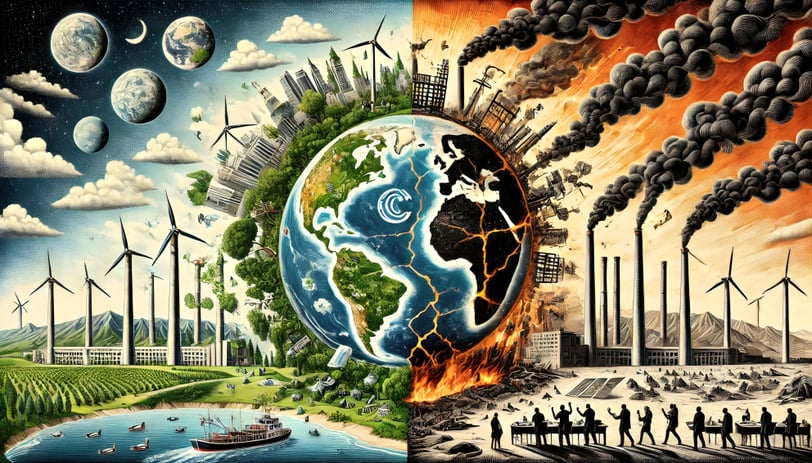Trade-wars, and the emerging new climate scenario after U.S. withdrawal from Paris Accord
The Paris Climate Accord, adopted by nearly 200 nations in 2015, represents a global commitment to mitigate climate change. This intricate agreement, however, has faced opposition, most notably with the United States' withdrawal under Donald Trump.
EXPERT ANALYSIS
GeopoliticsTv Team
1/25/20253 min read


The Paris Climate Accord, a cornerstone of international environmental diplomacy, was conceived in December 2015 in the French capital. It brought together nearly 200 nations with a unified aspiration: to forestall the dire repercussions of global temperature escalation. This seminal pact, effectuated on 4 November 2016, remains pivotal in global efforts to curtail greenhouse gas emissions and mitigate climate adversity.
The Cornerstones of the Paris Accord
1. Temperature Regulation:
Nations committed to endeavoring to restrict global temperature augmentation to "well below" 2.0°C above pre-industrial levels, with an ambitious pursuit of capping it at 1.5°C.
2. Net Zero Ambition:
By the latter half of the 21st century, the accord seeks a balance between anthropogenic emissions and their removal from the atmosphere, striving for a net-zero equilibrium.
3. Individualized Goals:
Each signatory established bespoke emissions-reduction benchmarks, revisited quinquennially to foster enhanced aspirations.
4. Climate Finance:
Wealthier nations pledged fiscal assistance to developing countries to fortify their resilience against climate impacts and transition towards renewable energy.
Why Trump Withdrew from the Accord
On his inaugural day in office, President Donald Trump promulgated his intent to extricate the United States from the agreement, branding it an affront to national sovereignty and a fiscal albatross. Trump’s administration posited that the accord disproportionately burdened the U.S., jeopardizing economic vitality. Despite being the globe's second-largest emitter of greenhouse gases, the U.S. opted for departure, a process finalized under UN protocols after a yearlong withdrawal period.
President Trump had withdrawn United States from Paris climate deal calling the deal ‘unfair’ and ‘one-sided’ and that the U.S. will ‘not sabotage its own industries while China polluted with impunity’.
China is the largest green-house gas emitter in the world, followed by the United States. It is the second time the U.S. is withdrawing itself from the Paris Accord. In 2017, trump had signed an order to withdraw the nation from the Accord but his successor Joe Biden had re-entered in 2021. This time, after taking over Trump withdrew from the accord again.
The 1.5°C Threshold: A Crucial Benchmark
The 1.5°C target epitomizes the threshold for averting catastrophic climatic transformations. Incremental temperature rises exacerbate phenomena such as protracted heatwaves, intensified cyclones, and escalating sea levels. The UN posits the following repercussions of surpassing 1.5°C versus reaching 2.0°C:
Mid-latitude heatwaves could average 4°C higher at 2.0°C.
Sea levels may rise an additional 0.1m, endangering up to 10 million individuals.
Coral reef devastation may exceed 99%, compared to 70-90% at 1.5°C.
Progress and Shortcomings Since Paris
Annual global summits, or COPs, convene to evaluate progress and recalibrate commitments. The Paris Accord’s initial targets were acknowledged as insufficient for meeting the 1.5°C goal. Presently, global policies place the planet on a trajectory of 2.6-2.8°C warming by 2100. Although net-zero pledges could reduce this to 1.9°C, intensified action is imperative.
COP28 in 2023 marked a nascent consensus on transitioning from fossil fuels, albeit devoid of obligatory measures. COP29 in 2024 saw little substantive progress on this front.
Aid for Developing Nations: A Contentious Arena
The accord reiterated a 2009 promise: affluent nations would mobilize $100 billion annually by 2020 for climate finance. This goal, achieved belatedly in 2022, expanded at COP29, where countries committed $300 billion annually by 2035, with aspirations of mobilizing $1.3 trillion through public and private sources. Despite this, developing nations decried the pledge as insufficient to address burgeoning climate adversities.
The Paris Climate Accord stands as an emblem of global unity in the fight against climate change. Yet, its efficacy hinges on sustained political will, equitable financial support, and resolute action from both developed and developing nations.
China’s Africa Expansion
China has been working with over 30 African countries and a few weeks ago, Chinese Foreign Minister Wang Yi visited Namibia, the Republic of the Congo, Chad and Nigeria from January 5 to 11. China’s main interest in these African countries is mining.
While green-house effect is going to witness a sharp rise in the coming years due to heavy mining by different nations including that of China in African countries, Drill Baby Drill mission of the United States will only add to it. As the two big economies of the world get locked in trade expansion, arresting global warming appears an idealized goal. That other nations including the European Union nations which have their mining stakes in Africa show genuine concern to climate deal, appears remote.
Recent Natural Calamities
In 2024, natural disasters have hit many nations. Things like heavy rains, floods, cloud-bursts, drought have occurred in many countries. The recent incidents of wildfire in Los Angeles too can be seen as a natural disaster due to climate change and global warming.
To sum up
The failure of Azerbaijan summit, lukewarm concern of nations to Paris Accord including those nations which are signatories, point to a more fearful future.
